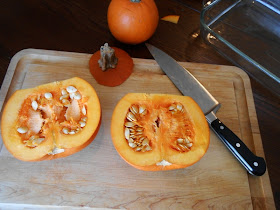The first step is to choose the right pumpkins. Can't I just use my Jack 'O' Lantern from Halloween? Well, technically you CAN cook it, but the pumpkins used for carving are generally not the type you want to cook with. Those pumpkins have a higher amount of water and a lower sugar content than "cooking pumpkins" which are called Sugar Pumpkins. Sugar pumpkins are smaller and rounder than carving pumpkins, and frequently a deeper shade of orange (See photo above). If you have trouble spotting them, ask for them at your local farm stand or pumpkin patch. Sugar pumpkins are usually NOT found in grocery stores.
After you have the right kind of pumpkin, you need to wash it and cut it open. Cutting a pumpkin can be done with a sturdy sharp knife, or you may find it useful to use the "mini saw" tool available in pumpkin carving kits. Cut the stem off and cut the pumpkin in half:
Scoop the seeds out with a large spoon: (You can save the seeds if you want to make roasted pumpkin seeds: Wash them, sprinkle with a little salt and roast at 400 degrees until golden brown. Cool before eating.)
Next, use a pumpkin scraper or similar kitchen tool to scrape the inside of the pumpkin, getting rid of the stringy threads.
Put the cleaned pumpkin halves in a roasting pan or pyrex casserole dish:
Preheat oven to 325 degrees. Bake the pumpkin for a minimum of one hour, or until you poke it with a fork and the interior is nice and soft. (One hour was the time I used for my small pumpkins, but you may need to adjust accordingly. Don't worry about overcooking - at this low temp the pumpkins will be fine as long as you check them every ten minutes or so around the one-hour mark.)
This is what my cooked pumpkin looked like (notice the many fork holes to check for doneness).
Cool the pumpkin until you can comfortably handle it, then scoop out the softened flesh:
Take the cooked pumpkin and puree it in a food processor or put it through a ricer like I did. (After using the ricer, I remembered why I used a food processor last time - the ricer works great but it is messy!) If you want it a little chunky, you could just mash it with a fork too. Either way, what you end up with should look something like this:
If it looks a little watery, you can put the mashed pumpkin in a fine-mesh strainer over a bowl and let it sit to drain for one hour up to overnight in the fridge. I never get much water out, so I just skip this step. But some people say it is useful.
Now you can use the pumpkin puree to make all sorts of dishes, savory and sweet!
Check out the recipe page to try my Pumpkin Pie, Spiced Pumpkin Squares, and Pumpkin Cake with Sage Whipped Cream.
.jpg)








No comments:
Post a Comment